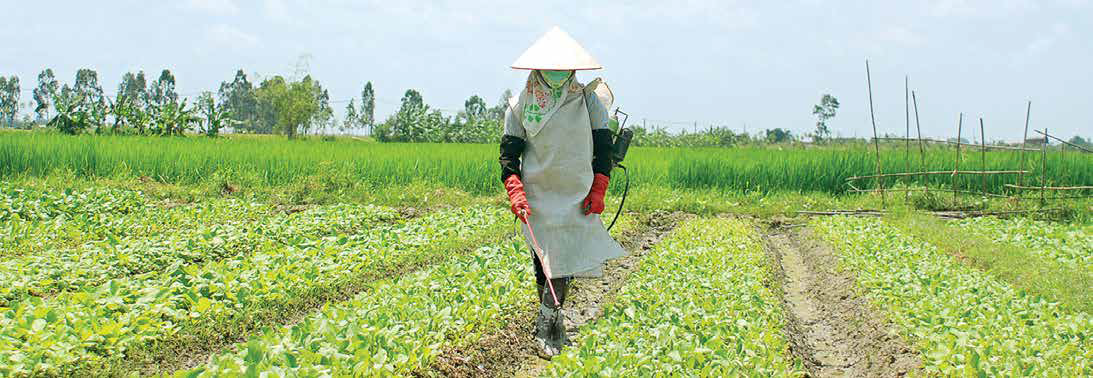Effective Management of Highly Hazardous Pesticides
By definition, crop protection products are designed to protect crops from insects, diseases and weeds. They do so by controlling pests that infect, consume or damage crops. Uncontrolled pests significantly reduce the quantity and quality of food production. It is estimated that annual crop losses could double without the use of crop protection products.
All of these products are intensively tested and regulated around the world to ensure they don’t cause unacceptable adverse effects to humans, non-target wildlife or the environment. Some products are highly toxic in order to control a group of specific pests or highly threatening diseases. Risk assessment and management identify the appropriate uses for crop protection products and promote stewardship measures for their responsible use.
According to the International Code of Conduct on Pesticide Management (“Code”), Highly Hazardous Pesticides (HHPs) are pesticides that are acknowledged to present particularly high levels of acute or chronic hazards to health or the environment (see the full definition on page 4 of the Code here).
CropLife International supports the Code, which calls for regulating crop protection products based on risk, not hazard. A risk-based approach prevents the restriction or banning of effective, useful products that pose minimal risk under proper use conditions and help farmers feed a growing population.
The hazardous nature of these crop protection products alone does not make them HHPs. What really matters is their risk versus benefits under recommended use conditions. The crop protection industry is committed to ensuring that such risk is appropriately addressed and minimized so a variety of products are available to help protect crops, people and the environment. Besides, the benefits of certain uses of HHPs may outweigh their risks by controlling pests that spread disease or threaten the food supply.
Risk Management
The Code stipulates that “prohibition of the importation, distribution, sale and purchase of highly hazardous pesticides may be considered if, based on risk assessment, risk mitigation measures or good marketing practices are insufficient to ensure that the product can be handled without unacceptable risk to humans and the environment.” CropLife International is striving to work with the UN Food and Agriculture Organization (FAO) and other stakeholders to promote risk-based management of HHPs around the globe.This includes identifying highly toxic products for priority risk assessment per intended use and geography and to mitigate potentially unacceptable risks. Risks should be weighed against the need for the product, benefits of its use and availability of alternatives which also need to be evaluated for risks and benefits.
Certain uses of HHPs may be desirable when they benefit society by controlling pests that spread disease or threaten the food supply. For example, while no longer used in agriculture, DDT remains an important tool in reducing human exposure to malaria. Removing this major disease control agent from the market altogether would put people at greater risk. Similarly, substances to control rats and other rodents (rodenticides) protect humans against the spread of diseases.
Risk Mitigation
The crop protection industry protects people and the environment by following very stringent product development criteria, whereby thousands of chemicals are analyzed and those with potential negative side effects are screened out from the very beginning. Products are then thoroughly tested according to local regulatory requirements and international standards. If they are safe for intended uses, they are delivered to the market responsibly. The industry then offers product support and stewardship training as well as promotes responsible handling practices. These necessary business operations ensure product sustainability and longevity as well as protect society.
Moreover, the crop protection industry supports Integrated Pest Management (IPM), which calls for applying crop protection products only when needed, and conducts farmer training on IPM and responsible product use. In fact, the CropLife International network has carried out many initiatives around the world to promote the responsible transport, storage, use and disposal of crop protection products. Farmers who follow such guidance and label instructions protect themselves and their farms from adverse effects as well as protect growing and harvested crops.
Finally, the industry continuously improves product formulations and packaging with human and environmental protection in mind. For example, it has put in place safety measures to prevent accidental or intentional misuse of products, such as safety seals and vomit-inducing ingredients. Liquid formulas may be switched to gels or microcapsules that don’t dissolve in water to prevent spillage and make them difficult to drink. Prominent warnings on labels along with suitably-sized and easy-to-handle containers discourage decanting products into unlabeled, inappropriate containers. Coloring or adding a strong smell to products to avoid mistaken identity, child- or spill-resistant caps and built-in measuring devices also help protect farmers and their families. Finally, products may be restricted in use per application or geography and/or only be sold to professional applicators.
Regulation of HPPs
Like all crop protection products, HHPs must be regulated by national governments to ensure there are no unacceptable risks to human or environmental health at the local level. The crop protection industry adheres to these regulations. In addition, CropLife International members are voluntarily committed to managing potential risks posed by HHPs by:
• reviewing their product portfolios regularly to identify products that meet HHP criteria;
• conducting use assessments on products/formulations under various conditions of use in specific geographies;
• taking measures to manage any HHP risks, which may include several mitigation measures or individual companies choosing to withdraw a product or use(s);
• encouraging global stakeholders to adhere to similar risk management measures; and
• building capacity for risk assessment in developing countries.
Click here to download more information about CropLife International’s approach to risk management of HHPs
